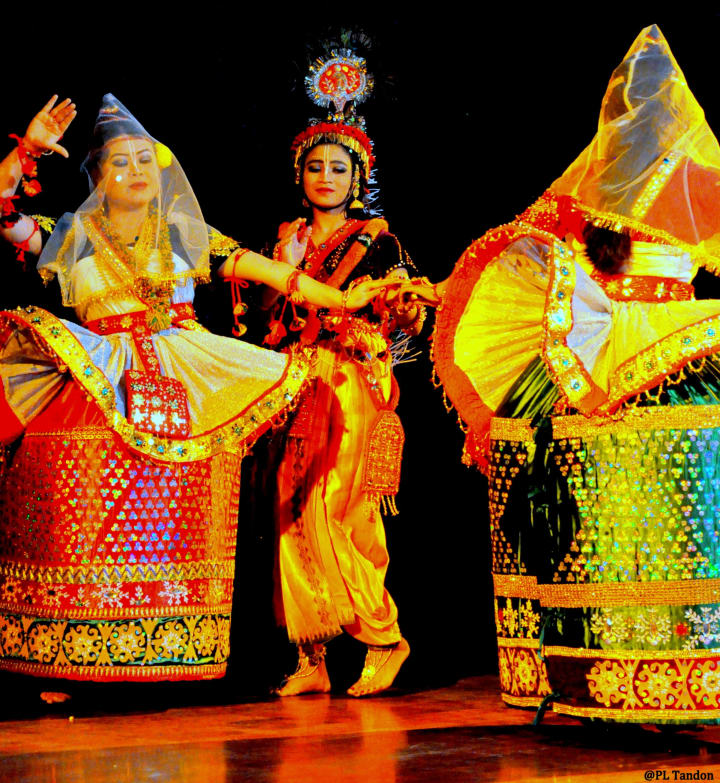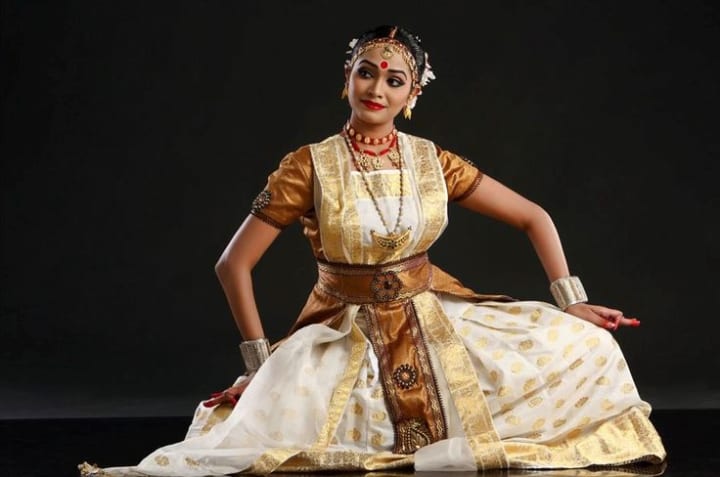"Diversity in Motion: Exploring the Rich Dance Forms of India"
"Unveiling the Cultural Significance and Timeless Beauty of India's Traditional Dances"

India is a land of diverse cultures and traditions, and each region of the country has its own unique dance forms that reflect its culture and heritage. Here are some of the popular dances of India:
1.Bharatanatyam
Bharatanatyam: Bharatanatyam is a classical dance form that originated in Tamil Nadu. It is characterized by its intricate footwork, hand gestures, and facial expressions.

History: Bharatanatyam has a long history that can be traced back to the ancient temples of Tamil Nadu, where it was performed by temple dancers known as Devadasis.
Dance Elements: Bharatanatyam is characterized by its precise and intricate footwork, which is accompanied by hand gestures and facial expressions that convey the emotions and narrative of the dance.
Music: Bharatanatyam is performed to classical Carnatic music, which uses a complex system of rhythm and melody.
Costume: The costume for Bharatanatyam is traditionally a saree for women and dhoti for men, along with elaborate jewelry and makeup.
Themes: Bharatanatyam often tells stories from Hindu mythology and religious scriptures, and also portrays themes of love, devotion, and spirituality.
Global Recognition: Bharatanatyam has gained global recognition and is now performed and taught in many countries around the world.
Bharatanatyam is a beautiful and expressive classical dance form that has evolved over centuries and continues to thrive in both its traditional and contemporary forms.
2.Kathak
Kathak;Kathak is a classical dance form that originated in northern India. It is characterized by its fast footwork, graceful movements, and intricate storytelling.

History: Kathak has a long history that can be traced back to the Mughal courts of northern India, where it was performed by courtesans known as tawaifs.
Dance Elements: Kathak is characterized by its fast footwork, which is accompanied by graceful movements of the arms, hands, and torso. The dance also incorporates intricate hand gestures and facial expressions that convey the emotions and narrative of the dance.
Music: Kathak is performed to classical Hindustani music, which uses a complex system of rhythm and melody.
Costume: The costume for Kathak is traditionally a long flowing skirt or lehenga, along with a choli (blouse) and dupatta (scarf). The dancer also wears elaborate jewelry and makeup.
Themes: Kathak often tells stories from Hindu mythology and religious scriptures, and also portrays themes of love, devotion, and spirituality.
Training: Kathak requires extensive training in order to master the intricate footwork and movements, as well as the hand gestures and facial expressions. It typically takes several years of dedicated practice to become proficient in the dance form.
Global Recognition: Kathak has gained global recognition and is now performed and taught in many countries around the world.
3.Kathakali

Kathakali is a classical dance form that originated in the southern state of Kerala, India, and is known for its elaborate makeup, costumes, and facial expressions. Here are some key features of Kathakali:
History: Kathakali has a long history that can be traced back to the 17th century, where it was performed in temple courtyards and royal palaces in Kerala.
Dance Elements: Kathakali is characterized by its elaborate makeup, costumes, and facial expressions. The dance also incorporates elaborate hand gestures and footwork that convey the emotions and narrative of the dance.
Music: Kathakali is performed to classical Carnatic music, which uses a complex system of rhythm and melody.
Costume: The costume for Kathakali is traditionally a colorful, heavy, and voluminous dress, along with elaborate headgear and makeup that can take several hours to apply.
Themes: Kathakali often tells stories from Hindu mythology and religious scriptures, and also portrays themes of love, devotion, and spirituality.
Training: Kathakali requires extensive training in order to master the elaborate makeup, costumes, and facial expressions, as well as the hand gestures and footwork. It typically takes several years of dedicated practice to become proficient in the dance form.
Global Recognition: Kathakali has gained global recognition and is now performed and taught in many countries around the world.
Kathakali is a unique and captivating classical dance form that showcases the rich cultural heritage of Kerala and continues to inspire and fascinate audiences with its elaborate costumes, makeup, and facial expressions.
4.Manipuri
Manipuri is a classical dance form that originated in the northeastern state of Manipur, India, and is known for its graceful movements, delicate hand gestures, and vibrant costumes.

Here are some key features of Manipuri:
History: Manipuri has a long history that can be traced back to ancient times, where it was performed as a devotional dance in temples and villages in Manipur.
Dance Elements: Manipuri is characterized by its graceful movements, delicate hand gestures, and fluid footwork that is accompanied by live music and singing.
Music: Manipuri is performed to classical Manipuri music, which is characterized by its use of indigenous instruments such as the pung (drum), pena (stringed instrument), and kartal (cymbals).
Costume: The costume for Manipuri is traditionally a colorful and voluminous skirt, along with a choli (blouse) and a transparent veil. The dancers also wear elaborate jewelry and makeup.
Themes: Manipuri often tells stories from Hindu mythology and religious scriptures, as well as themes from Manipuri folklore and history.
Training: Manipuri requires extensive training in order to master the graceful movements and delicate hand gestures, as well as the intricate footwork and expressions. It typically takes several years of dedicated practice to become proficient in the dance form.
Global Recognition: Manipuri has gained global recognition and is now performed and taught in many countries around the world.
Manipuri is a beautiful and elegant classical dance form that showcases the rich cultural heritage of Manipur and continues to inspire and captivate audiences with its graceful movements and vibrant costumes.
Sattriya
Sattriya is a classical dance form that originated in the northeastern state of Assam, India, and is known for its devotional and spiritual themes, intricate footwork, and expressive hand gestures.

History: Sattriya has a long history that can be traced back to the 15th century, where it was performed by monks in the monasteries of Assam as a form of worship.
Dance Elements: Sattriya is characterized by its intricate footwork, graceful movements, and expressive hand gestures. The dance also incorporates storytelling, singing, and live music.
Music: Sattriya is performed to classical Assamese music, which uses a unique system of ragas and talas.
Costume: The costume for Sattriya is traditionally a white dhoti and kurta for male dancers, and a white sari and blouse for female dancers. The dancers also wear traditional Assamese jewelry and makeup.
Themes: Sattriya often tells stories from Hindu mythology and religious scriptures, and also portrays themes of love, devotion, and spirituality.
Training: Sattriya requires extensive training in order to master the intricate footwork, expressive hand gestures, and graceful movements. It typically takes several years of dedicated practice to become proficient in the dance form.
Global Recognition: Sattriya has gained global recognition and is now performed and taught in many countries around the world.
Sattriya is a unique and spiritually uplifting classical dance form that showcases the rich cultural heritage of Assam and continues to inspire and fascinate audiences with its intricate footwork, expressive hand gestures, and devotional themes.
About the Creator
Enjoyed the story? Support the Creator.
Subscribe for free to receive all their stories in your feed. You could also pledge your support or give them a one-off tip, letting them know you appreciate their work.





Comments
There are no comments for this story
Be the first to respond and start the conversation.